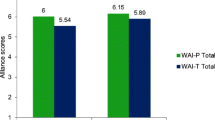ABSTRACT
This study considers the combined effect of therapist behaviors and couples’ interaction dynamics on therapeutic alliance because it seems to be a significant predictor of successful therapy outcomes. We measured therapeutic alliance using the Working Alliance Inventory, Observer Version (WAI-O), which includes three subscales: goals, tasks, and bond. We investigated the combined effect of therapist behaviors and couples interactions on therapeutic alliance. There were three significant findings: (1) the models better predicted therapeutic alliance for men clients than women clients; (2) combined consideration of partner behaviors and therapist behaviors provided the stronger prediction of therapeutic alliance; and (3) different variables predicted alliance for women clients versus men clients.
Similar content being viewed by others
References
American Association for Marriage and Family Therapy (1993). AAMFT catalog (p. 4). Alexandria, VA: Author.
J. F. Alexander (1988) Phases of family therapy process: A framework for clinicians and researchers L. C. Wynne (Eds) The state of the art in family therapy research: Controversies and recommendations Family Process Press New York 175–187
C. P. Barnard B. P. Kuehl (1995) ArticleTitleOngoing evaluation: In-session procedures for enhancing the working alliance and therapy effectiveness American Journal of Family Therapy 23 161–172
E. S. Bordin (1979) ArticleTitleThe generalizability of the psychoanalytic concept of the working alliance Psychotherapy Theory Research and Practice 16 252–260
E. S. Bordin (1994) Theory and research on the therapeutic working alliance: New directions A. O. Horvath L. S. Greenberg (Eds) The working alliance: Theory, research and practice John Wiley & Sons New York 13–37
A. U. Estrada J. M. Holmes (1999) ArticleTitleCouples perceptions of effective and ineffective ingredients of couple therapy Journal of Sex & Marital Therapy 25 151–162
J. M. Gottman (1999) The marriage clinic: A scientifically-based marital therapy Norton New York
A. S. Gurman (2001) ArticleTitleBrief therapy and family/couple therapy: An essential redundancy Clinical Psychology: Science and Practice 8 51–65
W. E. Hanson K. T. Curry D. L. Bandalos (2002) ArticleTitleReliability generalization of working alliance inventory scale scores Educational and Psychological Measurement 62 659–673
A. O. Horvath (1994) Empirical validation of Bordin’s pan theoretical model of the alliance: The working alliance inventory perspective A. O. Horvath L. S. Greenberg (Eds) The working alliance: Theory, research, and practice John Wiley & Sons New York 109–128
D. M. Kivlighan (1990) ArticleTitleRelation between counselors’ use of intentions and clients’ perception of working alliance Journal of Counseling Psychology 37 27–32
M. J. Patton D. M. Kivlighan K. D. Multon (1997) ArticleTitleThe Missouri psychoanalytic counseling research project: Relation of changes in counseling process to client outcomes Journal of Counseling Psychology 44 189–208
D. S. Rait (2000) ArticleTitleThe therapeutic alliance in couples and family therapy Psychotherapy in Practice 56 211–224
V. Tichenor C. E. Hill (1989) ArticleTitleA comparison of six measures of working alliance Psychotherapy 26 195–199
R. J. Werner-Wilson (1997) ArticleTitleIs therapeutic alliance influenced by gender in marriage and family therapy Journal of Feminist Family Therapy 9 3–16 Occurrence Handle10.1300/J086v09n01_02
R. J. Werner-Wilson T. S. Zimmerman S. J. Price (1999) ArticleTitleAre goals and topics influenced by gender and modality in the initial marriage and family therapy session? Journal of Marital and Family Therapy 25 253–262 Occurrence Handle10319296
Author information
Authors and Affiliations
Rights and permissions
About this article
Cite this article
Thomas, S.E.G., Werner-Wilson, R.J. & Murphy, M. Influence of Therapist and Client Behaviors on Therapy Alliance. Contemp Fam Ther 27, 19–35 (2005). https://doi.org/10.1007/s10591-004-1968-z
Issue Date:
DOI: https://doi.org/10.1007/s10591-004-1968-z




